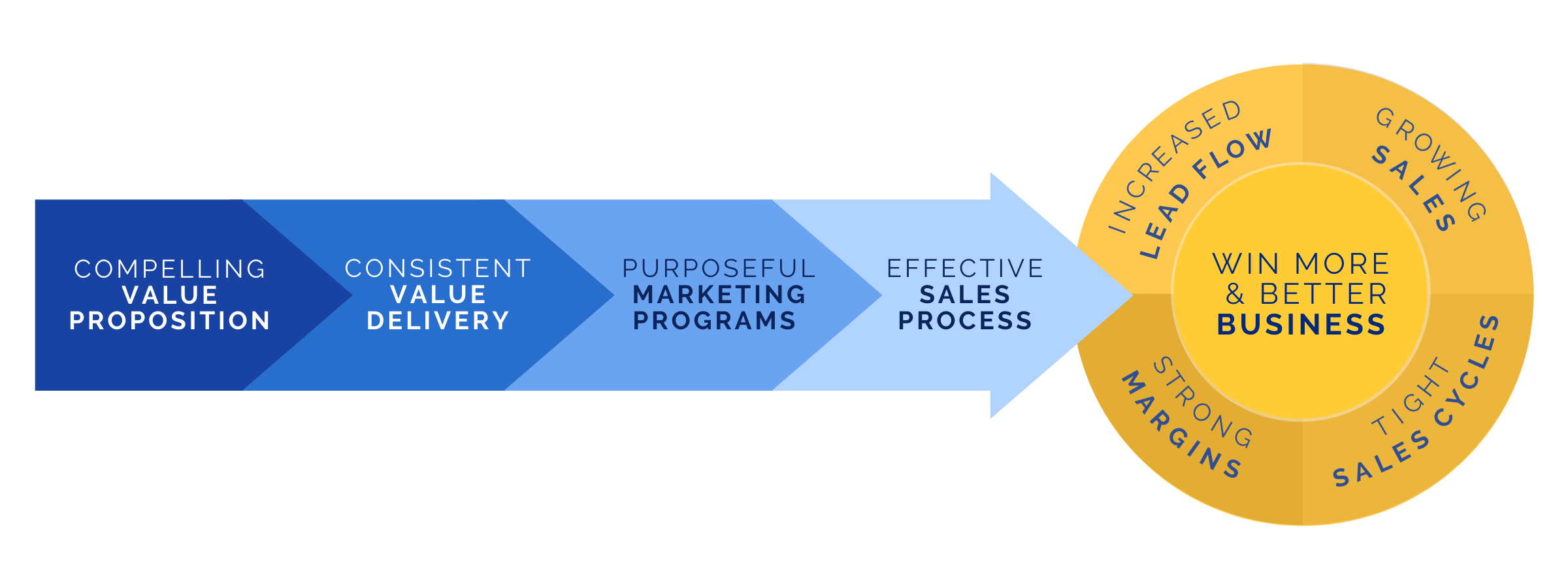10 Things You Can Do This Week to Reignite Growth
Feb 08, 2022
If you know anything about our approach at Value Prop, you know that we believe growth is about more than adding a bunch of sales and marketing "activity" to your plate.
Sure, sales and marketing are essential components of growth—but for established B2B businesses, there are really four components of your business you need to work on to achieve next-level growth.
In this article, we'll break down what those four components are and ten specific actions you can take this week to reignite growth.
The Four Keys to Growth
If you're the owner of a B2B company generating $2-20M in revenues, you probably have an innate sense that growth is complex. After all, your business is complex.
But just because growth is multifaceted doesn't mean that it has to be mysterious. Over the decades that we've worked with owners like you, we've established four key areas of any B2B business that are essential for growth.
- Your strategy: We're big believers in putting the "strategy horse" before the cart. This includes your targeting, your positioning, and most importantly, your value proposition.
- Your product: Whether you sell an actual product or are a service provider, your growth is directly impacted by how well you deliver value. We'll get into this more.
- Your marketing: From your website to your LinkedIn profile, your marketing programs should create value for your prospects before they even make a purchase decision.
- Your sales: You're probably more hands-on with closing deals than you would like to be. Having a sales process that is clear for your team, easy for your customers—and less dependent on you—is critical for growth.
We like to visualize these four keys like this.

Assuming the above makes sense, let's talk about what you can do this week to shore up each of these areas to spark growth.
Strategy
Getting out of the weeds and thinking big picture about what will actually move the "growth needle" is often the biggest obstacle we see owners struggle with.
Figuring out your strategy can sound like a daunting task—but it can be as simple as asking the right questions to the right people.
Action 1: Ask your best customers what they want.
The emphasis here is on your best customers—not your biggest, not your oldest. Your best. These are the customers that you and your team know are the most beneficial over the long-term, either because of the type of work they bring to you or even just their attitude. Building your business around your best customers is one of the greatest strategic decisions you can make for growth.
Once you've determined who your best customers are, ask them:
- What would they most love for you to start doing?
- What other products or services are they looking for to support what you provide for them?
- What do they wish you would stop doing?
Want help determining your best customer? Sign up for our free Ten Steps to Growth mini-course.

Action 2: Ask your team what they think is missing.
The next people you should turn to is your team—and we mean your whole team, not just your leadership or sales team. Growth is a whole company mission. From production to the front desk to upper management, everyone has a part to play.
Get your team together and ask them:
- What do they think is missing in your offerings?
- What desires or complaints do they hear from your prospects, customers, or providers?
- How can you capitalize on those opportunities to drive revenue?
Action 3: Identify your target customers’ biggest challenges.
Building your business around your target customer is only half the battle. Aligning your offering to their biggest challenge is how you'll create urgency (and more revenue) from your customer base.
Here's the tricky thing. Their biggest challenge may not be what you expect. In fact, it may seem like it has nothing to do with you. But if it affects them, it’ll affect you.
Look at your current customer base and identify which customers best represent your targets. Then, ask them:
- What challenges were you facing before you chose us?
- What alternatives were you considering, and what was appealing about them?
- What's happening in your world? Any big changes? (This is a great leading question to get an updated picture of what's weighing on your customers' minds right now.)
For more resources on how to execute these steps, check out our free mini-course, Ten Steps to Growth.
Product
Next, we get to "value delivery", i.e. your products or services. Growth happens when customers are delighted by how you solve their problems. Obviously, if you're failing to deliver your value well, then that's a hole in your boat that'll sink your growth. But another issue may simply be missing those "low-hanging fruit" opportunities to deliver value. Let's get into both pitfalls and the steps you can take to avoid them.
Action 4: Fix the #1 customer complaint about your product or service.

What irritates customers most about what you do? If you aren't sure, ask your team. If they aren't sure, send out a survey to your customers—or even better, just give them a call. When people are given an avenue to voice their issues, they will—so don't take it personally. You need to know.
Once you and your team get a pulse, act on it. Figure out what operational steps needs to be taken (or trained for) to solve this issue once and for all. And then, tell your customers about it. Let them know that you took them seriously and are excited to share your solution with them and get their feedback on it.
This is how you build trust and deliver value.
Action 5: Bundle a service with your core product.
If you sell a product, is there something additional you frequently get asked to do? Whether it's maintenance, installation, or something else, what service do your customers often want you to perform?
Now, you may be thinking "But we do that for free to add value. Charging customers for it would just make them mad." Maybe—but what if you souped up that service offering to make it even more valuable? If maintenance visits are free, what if you offered visits from your most experienced technician for an extra charge? Or increased the ease of making use of that service (i.e. automatic appointments?)
Action 6: Add a subscription offer.
Regardless of what you sell, there's sure to be something you do that your customers have a repeating need for. Whether it's wear parts, service calls, or another service offering, take that predictable problem and turn it into a subscription offer. Ask your customers:
- What problem would they love to have taken off their plate for good?
- What solution do they feel should be predictable or automatic?
- What problem would they like to always have a solution for?
Marketing
If the whole...everything...of marketing gives you a headache, don't worry. You don't have to be a marketing expert to take these next steps on your own. Think of it this way—marketing is just about making yourself available to your customers. At its most basic level, it has to accomplish these two goals:
- Making it clear what and whose problems you solve
- How prospects can learn more
Yes, you can go down the rabbit holes of content marketing, SEO, PPC, tradeshow strategy, etc. But for today, I want to you focus on these two things.
Action 7: Make sure your home page has simple ways for customers to contact you.
Go to your website and try to imagine stumbling upon it for the first time. Is it crystal clear what a customer is supposed to do if they want to ask you a question or get in contact with you? Is the process for getting in contact with you intimidating or cumbersome?
No amount of fancy marketing will make up for friction. If it isn't easy and simple, they won't take action—so make your website as buyer-friendly as possible.
Action 8: Make sure your LinkedIn Profile has a value statement for prospects.
LinkedIn remains the most important social media platform for B2B, but for many owners, it can feel like just another "thing to do". Without making you come up with a whole LinkedIn strategy, here's what I recommend you do: just update your profile.
Your headline (the description under your profile name) should include a value statement, not just your title and company name. But, before I lose you with "value statement", let me explain. All you want to do is make it obvious what problems you solve for customers—essentially, what's in it for them?
Something like "I help [TARGET CUSTOMER] solve [PROBLEM] without [THEIR BIGGEST ANNOYANCE]" is a great way to start.
For more help on leveraging your marketing efforts, sign up for our free mini-course, Ten Steps to Growth.
Sales
Lastly, and perhaps most obviously, growth comes down to sales. There's a lot I could say about sales and what goes into a tight sales process. But if you're looking to shake loose revenue now—not a year from now—here's what I recommend.
Action 9: Clean up your pipeline.

How many deals are sitting in your pipeline right now? If you're reading this, you may be thinking "Well, not enough..." but I challenge you to really take a look at the loose ends in your pipeline. Call anyone sitting on a proposal for over 60 days. Ask for status and find out what their timeline is. Sometimes all it takes is a simple call to shake some revenue loose.
Action 10: Review your top 10 deals.
Most urgently, review the top ten deals that you're working. Ask yourself this question, scary as it may be—if these deals were to fall through, why would that be? What you're trying to get a sense of are your vulnerabilities. Is there an alternative that you find your customers keep choosing? Is there an issue with your product or how it's positioned in the minds of your customers?
Once you have a picture of what your sales vulnerabilities are, meet with your team to determine what action steps you need to take to fix them. Revenue growth will often follow when you've patched those holes.
The Bottom Line
Revenue growth is complex—but it's not impossible or mysterious. When you tighten up across your strategy, product, marketing, and sales, you will see results. If you've taken any of these actions, let us know how they go. If you want any help executing these ideas, sign up for our free mini-course for B2B business owners, Ten Steps to Growth. Or feel free to explore how we work with owners who are hungry for next-level growth.


